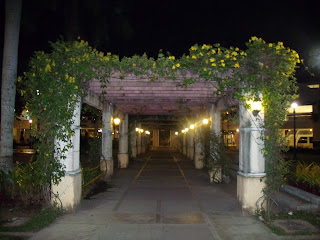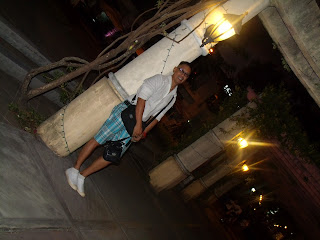Around 38 km southeast of Manila is a bustling chill-out area that's gaining ground amongst families and youngsters alike. Paseo de Sta. Rosa is a relatively medium sized mall with a lot to offer in terms of food and fashion.
I was there on a whim last Sunday. I got invited for a joy-ride by some friends and we had this great idea to head for the burbs. Sta. Rosa, it was! Cruising the highway (SLEX), make a beeline for the Sta. Rosa exit and then just follow the road past the Coke and Honda plants. You can't miss this spot as there are brilliant signages visible from the road.
We parked dutifully right in front of the Crocs outlet store. There are, incidentally, a lot of outlets that sell at considerably less than the specialty stores they have in Manila's malls. The imported brands are well represented., selling as much as 50-70% discount on their products.
I just spent most of my afternoon canvassing prices on shoes, bags, clothes, and junk food. Nike Park, Levi's, Crocs, Debenham's, Marks and Spencer, Timberland, and Payless have outlets here that sell original items that are not necessarily out of style in the main malls. And as far as dining is concerned, you name any kind of cuisine you're likely to find one there. Of course, Jollibee and the likes of Shakey's and KFC can't be far behind either. but some restaurants can actually surprise you.
If you have enough time, go visit the Solenade area. The property was developed by the Ayala group. Ergo, it made sure the development had little impact on the environment, if any. The area is popular as a hang-out for yuppies and students who want to relax and have a cup of cofee at the end of a long hard day. Incidentally, Sta. Rosa can now brag about having a couple of BPO's based in their neck of the woods.
Somehow the feel of the place has retained its provincial charm while trying to catch up to its neighboring communities like Alabang and Taguig. It's really a far cry from what it used to be in the Spanish times when this area was a Dominican estate that had families of indios laboring as farmers for the friars. Actually, up until the 1960's this was a hotbed of landowner-farmer disputes until the government decided to sell the farm lots to locals who wanted their own land. And as you guessed, the city was dedicated to Sta. Rosa de Lima in 1792. The economy was largely dependent on agriculture. In my childhood, the national flower, Sampaguita was so abundant in the area it became the main source f these fragrant garlands that were sold in the streets in Manila. Eventually, industrialization set in. There are now five malls in the area and factories of consumer products and BPOs provide employment for its residents.






No comments:
Post a Comment